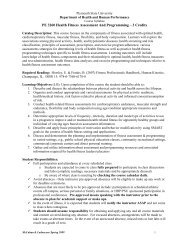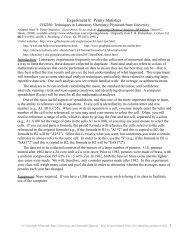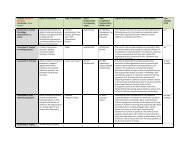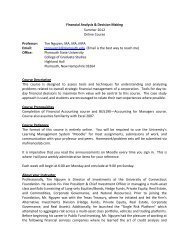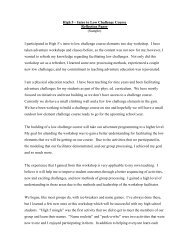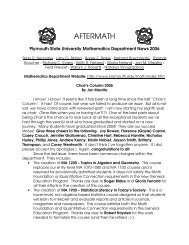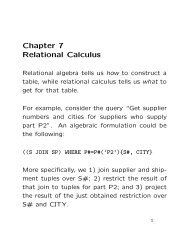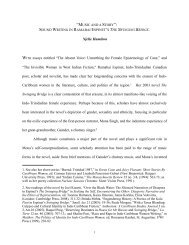Vol. 12 Issue 2 TIGER Curriculum Connections - Plymouth State ...
Vol. 12 Issue 2 TIGER Curriculum Connections - Plymouth State ...
Vol. 12 Issue 2 TIGER Curriculum Connections - Plymouth State ...
You also want an ePaper? Increase the reach of your titles
YUMPU automatically turns print PDFs into web optimized ePapers that Google loves.
<strong>Plymouth</strong> <strong>State</strong>T.I.G.E.R.UniversityProgramFeb-20<strong>12</strong><strong>Vol</strong>. <strong>12</strong> <strong>Issue</strong> 2 - <strong>TIGER</strong> ONLINECURRICULUM CONNECTIONSInside<strong>TIGER</strong>CUB CLUB<strong>TIGER</strong>TALE 3<strong>TIGER</strong>TEEN 4<strong>TIGER</strong> TEACHER 6<strong>TIGER</strong> CONNECTTO CURRICULUM<strong>TIGER</strong>TOME 8<strong>TIGER</strong>TUNE 9<strong>TIGER</strong>TIME OUT <strong>12</strong>27<strong>TIGER</strong> NewsTiger Alert!! Tiger Alert!!<strong>TIGER</strong> and New Hampshire PublicTelevision have started filming for afuture broadcast.Stay tuned for the exciting developments thatare yet to come.A new documentary movie called“Bully” is being released. The movieis set to premiere on March 30th intheaters around the country. Thispowerful film takes anin-depth look atthe bullying crisistaking place inthis country. Thismovie looks to be a noholds barred view of theproblem taking place in our schoolsand communities and looks to be amust see viewing for our schools andkids.
<strong>TIGER</strong>CUBClub<strong>TIGER</strong> Cub ActivitiesLittle Red Hen TheaterActivity for young students to develop character andstory interpretation.1. Teacher reads the story of the Little Red Hen,see Page 3, to the class.2. Students break into groups of four.3. Each student chooses to portray the role of Hen,Pig, Duck or Cat.4. Develop how each character will sound, talk andmove. (Note: The character voice cannot soundlike the student’s speaking voice.)5. Teacher goes from group to group and reads thestory. The actors practice their parts.6. Teacher reads the story to the entire class aseach group acts.7. Debrief after each group, noting the positivecharacter portrayals.8. Students create stick puppets using card stock,tagboard or old file folders.hisker WisdomDon’t Let Words Hurt9.Create a stage by draping ablanket or sheet over a rod orbroom handle between the topsof two adult sized chairs.10.Students now practice theirpuppet shows using their ownwords to tell the story.11.Groups present their shows toother classes.Building RhymesShort activity to encouragestudents to work together andcreate rhymes!1. Groups warm-up by standingin circles and creating rhymesfor Hen, Pig, Duck and Cat.2. Game - who in each group cango without repeating a priorword.3. Winners from each group cometogether for final round. Onefinal round for each word.2
<strong>TIGER</strong> ACTIVITIESFACTS ABOUTCYBERBULLYINGfrom nhbullywatch.orgDid you know:• 42% of kids have been bulliedwhile online. 1 in 4 have hadit happen more than once.• 35% of kids have beenthreatened online. Nearly 1in 5 have had it happen morethan once.• 21% of kids have receivedmean or threatening e-mailor other messages.• 58% of kids admit someonehas said mean or hurtfulthings to them online. Morethan 4 out of 10 say it hashappened more thanonce.• 53% of kids admit havingsaid something mean orhurtful to another persononline. More than 1 in 3have done it more thanonce.• 58% have not told theirparents oran adultaboutsomethingmean or hurtfulthat happened to themonline.Community Building1. QUESTION TABLEAUS – Students create spontaneoustableaus based on a single student’s answer to aquestion from the facilitator. Bring in questions thatstudents may respond to with single-word or shortphrase answers. General examples could include:• What makes you happy?• What is the relationship between the bully and victimwhen being Cyberbullied?• When bullied, where do you get your strength?Procedure: Once question is posed, wait for someone togive an answer (verbally, out loud) - “Whoever has ananswer and wants to share.”Repeat the answer to make sure everyone has heard.Ask the responder or the class, “What does this looklike?” One person can create the tableau, theneveryone repeats the action. Alternately, you can askeach student to create his or her own tableau. Explain,“I want you to hear the word, and then I want to seewhat it looks like.” Debrief at end to exploreand identify creative tableaus.2. ROLE PLAY - CyberBullyingRole playing the roles of bullyand victim to differentcyberbullying situations. First,d i s c u s s t h e d i f f e r e n t f o r m s o fcyberbullying. (Social Media, texting,computer, etc....) Second, students create twogroups, bully or victim. Third, discusscharacteristics of the two groups.Procedure: Teacher calls out a student namefrom the bully group. Bully goes to the front andthe teacher says ACTION! The Bully sets thescenario and acts out a cyber act of unkindness,teacher says CUT! Victim is chosen and goes tothe front, teacher says ACTION! Victim thenreacts with a negative, destructive outcome,teacher says CUT! Class discusses possiblepositive outcomes. After a few comments teachersays ACTION! Victim redoes scene acting out apositive outcome. CUT!5
Can you help?For Teachers who want toguide their students indealing with cyberbullying.•Keep personal informationprivate•Stop, block and tell•Google yourself•Don’t be an accomplice•Internet Golden RuleIt’s so easy for anyone tomisunderstand electroniccommunications. Be very, verycareful to make messages clearand help others to understandwhat we really mean. We alsoneed to be careful not to hurtothers and be good netizens.•Take 5 - Teaching kids to“Take 5!” before responding tosomething they encounteronline. Jokingly tell them to“Drop the Mouse! Step awayfrom the computer and no onewill get hurt!” Encourage themto find ways to calm down.<strong>TIGER</strong> TeacherWhat is Cyberbullying?“Cyberbullying” is being cruel to others by sending or posting harassing,harmful material or engaging in other forms of social cruelty by using theInternet or other digital technologies.Cyberbullying can include:Aggression, Threats, and Distress•Flaming – online “fights” using electronic messages.•Harassment – repeatedly sending offensive messages.•Denigration – sending or posting material about a person to damage his orher reputation or friendships.•Impersonation – posing as a person and posting material to make theperson look bad, get in trouble, or danger, or damage that person’sreputation or friendships.•Outing and trickery – sharing someone’s’ secrets or embarrassinginformation or images online or tricking someone into revealing suchinformation and then sharing.•Exclusion – intentionally excluding someone from an online group.•Cyberstalking – repeatedly sending threatening and intimidatingmessages or engaging in other online activities that make a person afraidfor his or her safety.For help see Proposed Letter to Parents at the end of newsletter.What New Hampshire's New Bullying LawMeans for SchoolsOctober 2010By Maria B. Matthews. from gcglaw.comOn June 15th, Governor Lynch signed the bullying bill into law. Itrepresents a significant rewrite and expansion of the Pupil Safety andViolence Protection Act which was originally enacted in 2000. With the newlaw in place, school districts must take a number of actions in order tocomply with the law and protect themselves from liability.By January 1, 2011, the school board of every district must adopt awritten policy that prohibits bullying and cyberbullying. The law sets forth14 components that need to be included in the district’s policy. Every policymust include procedures for reporting bullying and cyberbullying. Mostdistricts probably have a procedure like this in place. However, othercomponents may be new to a number of districts. For example, everybullying policy must include a statement prohibiting retaliation and falseaccusations. Policies must also include a process for developing plans toprotect students from retaliation.In addition, the new law directs school boards to include standarddefinitions for certain terms, including “bullying” and “cyberbullying.” Evenif a district has a bullying policy in place, it is unlikely to include thedefinitions required by the new law. “Bullying” must be defined to includeany written, verbal, or electronic communication, or physical act or gesturewhich:•Physically harms a student or damages his or her property6
<strong>TIGER</strong>Tunes<strong>TIGER</strong> SongDon’t Be a Cyber Bully!Lyrics by Trish LindbergMusic by William ÖgmundsonIf you use computers to make people feel bad.You really need to stop it!That’s cruel and very sad.....It’s time that we treat people with respect and dignity.So let’s be kind to others.When we use technologyFacebook, email, instant messaging.Texts and Twitters can all cause sufferingChoose your words quite carefullywhenever you’re online.What you say is powerful;Be a friend, be fair, be kind!If you use computers to make people feel bad.You really need to stop it!That’s cruel and very sad.It’s time that we treat people with respect and dignity.So let’s be kind to others.When we use technology.Be kind.OnlineBe kind!9
T.I.G.E.R. at <strong>Plymouth</strong><strong>TIGER</strong> (Theatre Integrating Guidance, Education,and Responsibility), recipient of a 2011 NewHampshire Partners in Education Gold Circle Award,is a powerful and exciting collaboration between theintegrated arts and the counselor education graduateprograms at <strong>Plymouth</strong> <strong>State</strong> University. <strong>TIGER</strong> is aprofessional theatre company designed to helpchildren, schools, parents, and communities dealproactively and positively with social issues andconcerns facing children in schools today.<strong>12</strong><strong>TIGER</strong> Time OutActivities for Teachers &Students to do Together<strong>Plymouth</strong> <strong>State</strong>UniversityT.I.G.E.R.ProgramTo Book <strong>TIGER</strong> pleasecontact Pamela Irish,<strong>TIGER</strong> Tour Managercall (603) 535-2647fax (603) 535-2879.“WE ALL HAVE DREAMS”We all have dreams....don’t we? Create a bulletin board expressingyour dreams and hopes.Each Student will write three sentences that start with, “I dream ofa world that.....” Also, three sentences that start with, “I dream of aschool that......” Finally, three sentences that start with, “I dream of ahome that.........”Materials printer paper, markers, coloredpencils, dark construction paper.Create the Bulletin Board and Posters1.Students choose their favorite dreamsentence from each list. Enter these on thecomputer, each sentence should fill alandscape sheet of paper.2.Using three sheets of printer paper, create an abstract design oneach, using colored pencils and markers. One design thatrepresents Home, one School and one The World. (NOTE:Teachers may want to limit the color choices to lighter coloredmaterials, which will allow the printer ink to show.)3.Print the Home sentence from Step 1 on the Home design paper.4.Repeat on the rest of the sheets.5.Cover bulletin board with dark paper to emphasize designs andsentences.6.Place the “I dream of a school.......” as posters around the school.7.Integrate the remaining sentence designs into the bulletin board.Extend Activity Each student writes a paragraph about theselected dream from each list. Students present their paragraphs totheir classmates as a read aloud or in an assembly.See you in March
PROPOSED LETTER TO PARENTSDATESCHOOL BOARDLOCAL SCHOOLRE: CyberbullyingDear Parent or Guardian:As you may already know, there are many Internet sites and chat rooms (i.e. MySpace,Facebook, Xanga, MSMSpaces) which have become a popular social networking destination formillions of children nationwide. Unfortunately, according to law enforcement records, they arealso popular with sexual predators, cyber bullies, and con artists.Everything posted on most of these sites can be seen by anyone with Internet access. Often thesesites have privacy features which allow a teen to limit access only to people they know, however,these privacy features are not foolproof. When unsuspecting students post personal information,they become easy targets for predators – people who can use this information to identify, locate,and contact them. Cyberbullying is also an increasing issue. Cyber bullies – generally ages 9 –15, often use the instant-messaging feature of these sites to chat or post hurtful or threateningmessages online. Such bullying can be very damaging to children.We encourage you to be aware of these chat rooms and search for your children by name, e-mailaddress, etc. If they’re registered users, you can visit their accounts, just like anyone else (forexample conduct a Google search using your child’s name and screen name). You can also justask your children if they are using these sites and go online with them, explaining the types ofthings that they should or should not post. Everyone knows that often we e-mail in haste, andthat taking a minute to cool down or think before hitting “send” is always a good idea.Below are some questions you can cover with your children, explaining that they should askthemselves these questions before posting something: (from 10 Willard, N (2007) Cyber-SafeKids, Cyber-Savvy Teens: Helping Young People Learn to Use the Internet Safely andResponsibly. Jossey-Bass.)•“Is this kind and respectful to others?”•“How would I feel if someone did or said the same thing to me, or to my best friend?”•What would my mom, dad, or other trusted adult think or do?”•“Would I violate any agreements, rules, or laws?”•“How would I feel if my actions were reported on the front page of a newspaper?”•“What would happen if everybody did this?”•“Would it be okay if I did this in Real Life?”•“How would this reflect on me?”•“Does it just feel “wrong” to do this? If so, I should not do it.”There are other things that you, as the parent, can do to help keep you child safe while online.15
These include:•Keep computers with web access in public parts of the house, such as the living room.•Set Internet rules and guidelines and post the rules near the computer or have a contractwith your child about the use of the computer.•Decide whether your children may use MySpace.com or similar social networking sites.•Know your child’s screen name and what they have listed on their profile.•Let your children know that you will be reviewing their account for appropriate content andappropriate sites and then periodically review your children’s Internet (history) accounts.•Talk with your children – calmly. While online communication is a common part of preteenand teen social life, many children are unaware of its dangers.To learn more about Internet safety, visit the Attorney General’s Internet Crimes Unit websiteat www.connectwithyourkids.org., or call the Internet Crimes Prosecutor, Lucy H. Carrillo, at603-271-3673. Other sites with helpful information on Internet safety and cyberbullying arewww.isafe.org; www.benetsafe.org; www.wiredsafety.org; http://cyber-safe-kids.com, and http://staysafeonline.org.Sincerely,NAMEPRINCIPAL OF LOCAL SCHOOLNAMELOCAL SCHOOL DISTRICTLyonel B. TracyCommissioner, Department of EducationKelly A. AyotteNew Hampshire Attorney General16





